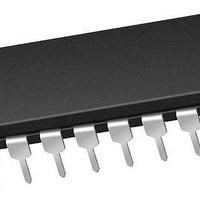PIC16F1829-E/P Microchip Technology, PIC16F1829-E/P Datasheet - Page 248

PIC16F1829-E/P
Manufacturer Part Number
PIC16F1829-E/P
Description
14 KB Flash, 1K Bytes RAM, 32 MHz Int. Osc, 18 I/0, Enhanced Mid Range Core 20 P
Manufacturer
Microchip Technology
Series
PIC® XLP™ mTouch™ 16Fr
Datasheet
1.PIC16LF1829-ISO.pdf
(420 pages)
Specifications of PIC16F1829-E/P
Core Processor
PIC
Core Size
8-Bit
Speed
32MHz
Connectivity
I²C, LIN, SPI, UART/USART
Peripherals
Brown-out Detect/Reset, POR, PWM, WDT
Number Of I /o
17
Program Memory Size
14KB (8K x 14)
Program Memory Type
FLASH
Eeprom Size
256 x 8
Ram Size
1K x 8
Voltage - Supply (vcc/vdd)
1.8 V ~ 5.5 V
Data Converters
A/D 12x10b
Oscillator Type
Internal
Operating Temperature
-40°C ~ 125°C
Package / Case
*
Processor Series
PIC16F182x
Core
PIC
Data Bus Width
8 bit
Data Ram Size
1 KB
Interface Type
I2C, SPI, USART
Maximum Clock Frequency
32 MHz
Number Of Programmable I/os
18
Number Of Timers
5
Operating Supply Voltage
1.8 V to 5.5 V
Maximum Operating Temperature
+ 125 C
Mounting Style
Through Hole
Lead Free Status / RoHS Status
Lead free / RoHS Compliant
Lead Free Status / RoHS Status
Lead free / RoHS Compliant
- Current page: 248 of 420
- Download datasheet (5Mb)
PIC16F/LF1825/1829
25.2.2
When initializing the SPI, several options need to be
specified. This is done by programming the appropriate
control bits (SSPxCON1<5:0> and SSPxSTAT<7:6>).
These control bits allow the following to be specified:
• Master mode (SCKx is the clock output)
• Slave mode (SCKx is the clock input)
• Clock Polarity (Idle state of SCKx)
• Data Input Sample Phase (middle or end of data
• Clock Edge (output data on rising/falling edge of
• Clock Rate (Master mode only)
• Slave Select mode (Slave mode only)
To enable the serial port, SSPx Enable bit, SSPxEN of
the SSPxCON1 register, must be set. To reset or recon-
figure SPI mode, clear the SSPxEN bit, re-initialize the
SSPxCONx registers and then set the SSPxEN bit.
This configures the SDIx, SDOx, SCKx and SSx pins
as serial port pins. For the pins to behave as the serial
port function, some must have their data direction bits
(in the TRIS register) appropriately programmed as fol-
lows:
• SDIx must have corresponding TRIS bit set
• SDOx must have corresponding TRIS bit cleared
• SCKx (Master mode) must have corresponding
• SCKx (Slave mode) must have corresponding
• SSx must have corresponding TRIS bit set
FIGURE 25-5:
DS41440A-page 250
output time)
SCKx)
TRIS bit cleared
TRIS bit set
SPI MODE OPERATION
SPI Master SSPxM<3:0> = 00xx
MSb
Serial Input Buffer
Processor 1
Shift Register
SPI MASTER/SLAVE CONNECTION
(SSPxSR)
(BUF)
= 1010
LSb
General I/O
SCKx
SDOx
SDIx
Preliminary
Serial Clock
Slave Select
(optional)
Any serial port function that is not desired may be
overridden by programming the corresponding data
direction (TRIS) register to the opposite value.
The MSSPx consists of a transmit/receive shift register
(SSPxSR) and a buffer register (SSPxBUF). The
SSPxSR shifts the data in and out of the device, MSb
first. The SSPxBUF holds the data that was written to
the SSPxSR until the received data is ready. Once the
8 bits of data have been received, that byte is moved to
the SSPxBUF register. Then, the Buffer Full Detect bit,
BF of the SSPxSTAT register, and the interrupt flag bit,
SSPxIF, are set. This double-buffering of the received
data (SSPxBUF) allows the next byte to start reception
before reading the data that was just received. Any
write
transmission/reception of data will be ignored and the
write collision detect bit WCOL of the SSPxCON1
register, will be set. User software must clear the
WCOL bit to allow the following write(s) to the
SSPxBUF register to complete successfully.
When the application software is expecting to receive
valid data, the SSPxBUF should be read before the
next byte of data to transfer is written to the SSPxBUF.
The Buffer Full bit, BF of the SSPxSTAT register,
indicates when SSPxBUF has been loaded with the
received data (transmission is complete). When the
SSPxBUF is read, the BF bit is cleared. This data may
be irrelevant if the SPI is only a transmitter. Generally,
the MSSPx interrupt is used to determine when the
transmission/reception has completed. If the interrupt
method is not going to be used, then software polling
can be done to ensure that a write collision does not
occur.
SDOx
SDIx
SCKx
SSx
to
SPI Slave SSPxM<3:0> = 010x
MSb
the
Serial Input Buffer
Shift Register
(SSPxBUF)
(SSPxSR)
Processor 2
SSPxBUF
2010 Microchip Technology Inc.
LSb
register
during
Related parts for PIC16F1829-E/P
Image
Part Number
Description
Manufacturer
Datasheet
Request
R

Part Number:
Description:
IC, 8BIT MCU, PIC16F, 32MHZ, SOIC-18
Manufacturer:
Microchip Technology
Datasheet:

Part Number:
Description:
IC, 8BIT MCU, PIC16F, 32MHZ, SSOP-20
Manufacturer:
Microchip Technology
Datasheet:

Part Number:
Description:
IC, 8BIT MCU, PIC16F, 32MHZ, DIP-18
Manufacturer:
Microchip Technology
Datasheet:

Part Number:
Description:
IC, 8BIT MCU, PIC16F, 32MHZ, QFN-28
Manufacturer:
Microchip Technology
Datasheet:

Part Number:
Description:
IC, 8BIT MCU, PIC16F, 32MHZ, QFN-28
Manufacturer:
Microchip Technology
Datasheet:

Part Number:
Description:
IC, 8BIT MCU, PIC16F, 32MHZ, QFN-28
Manufacturer:
Microchip Technology
Datasheet:

Part Number:
Description:
IC, 8BIT MCU, PIC16F, 32MHZ, SSOP-20
Manufacturer:
Microchip Technology
Datasheet:

Part Number:
Description:
IC, 8BIT MCU, PIC16F, 20MHZ, DIP-40
Manufacturer:
Microchip Technology
Datasheet:

Part Number:
Description:
IC, 8BIT MCU, PIC16F, 32MHZ, QFN-28
Manufacturer:
Microchip Technology
Datasheet:

Part Number:
Description:
IC, 8BIT MCU, PIC16F, 20MHZ, MQFP-44
Manufacturer:
Microchip Technology
Datasheet:

Part Number:
Description:
IC, 8BIT MCU, PIC16F, 20MHZ, QFN-20
Manufacturer:
Microchip Technology
Datasheet:

Part Number:
Description:
IC, 8BIT MCU, PIC16F, 32MHZ, QFN-28
Manufacturer:
Microchip Technology
Datasheet:

Part Number:
Description:
MCU 14KB FLASH 768B RAM 64-TQFP
Manufacturer:
Microchip Technology
Datasheet:

Part Number:
Description:
7 KB Flash, 384 Bytes RAM, 32 MHz Int. Osc, 16 I/0, Enhanced Mid Range Core, Low
Manufacturer:
Microchip Technology

Part Number:
Description:
14KB Flash, 512B RAM, 256B EEPROM, LCD, 1.8-5.5V 40 UQFN 5x5x0.5mm TUBE
Manufacturer:
Microchip Technology
Datasheet:










